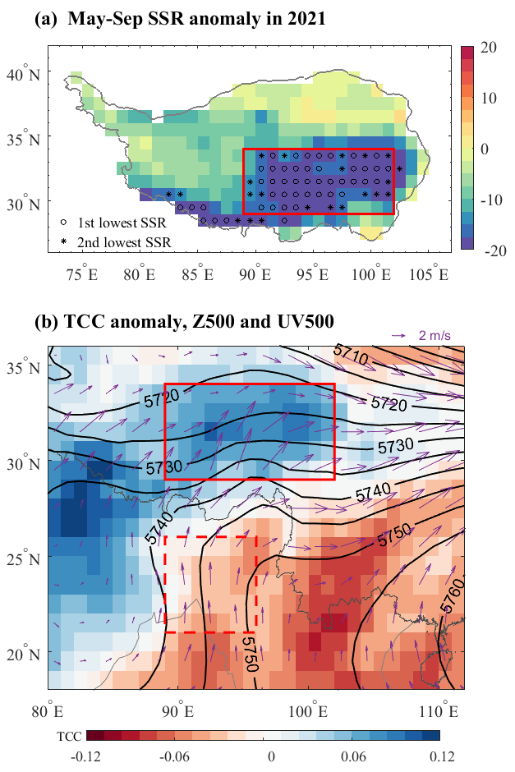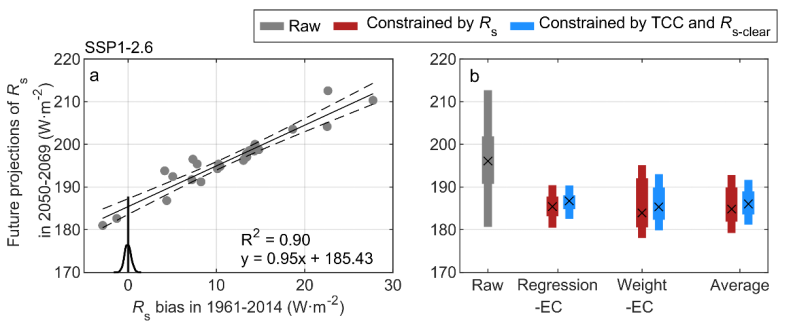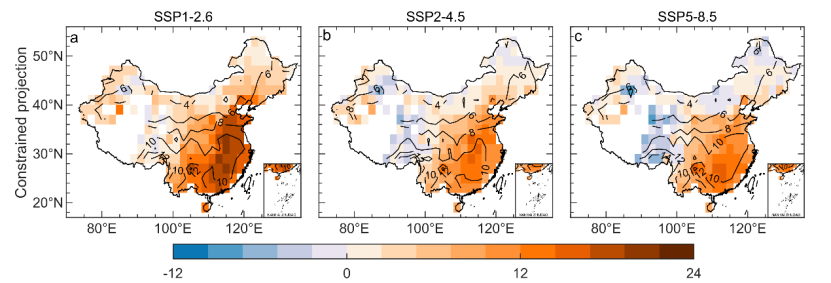With the increasing shortage of fossil energy and air pollution, solar energy sees its rapid development as a clean and renewable energy. Developing and utilizing solar energy is one of the important ways to achieve the goals of “carbon neutrality and carbon peaking” in China. Seasonal extremely low solar radiation events seriously threaten the stability of photovoltaic power generation systems, and the future change of solar radiation is also one of the bases for planning the photovoltaic industry. In order to solve this problem, Yang Kun's Research Group of the Department of Earth System Science (DESS), Tsinghua University has analyzed an extreme radiation event on the Tibetan Plateau in 2021 and predicted the future radiation change pattern of China.
The study finds that in the 2021 monsoon period, i.e., May–September, southeastern Tibetan Plateau (SETP; 29°–34°N, 89°–102°E; red box in Fig. 1a) registered a widespread and extremely low SSR since 1950 with approximately -18.7 W m-2 of the regional mean anomaly relative to the 1950-79 mean (Figs. 1a). The Research Group explores possible causes of this event from two aspects, natural forcing and anthropogenic forcing, and investigates into its potential impacts on local vegetation growth.

Fig. 1 (a) May-Sep SSR anomaly in 2021 relative to the 1950-1979 mean; (b) Spatial distribution of TCC anomalies (shading), the 500 hPa geopotential height (Z500; contours), and wind vector (UV500) in May–September 2021.
The South Asian monsoon transports a large amount of water vapor to southeast Tibet during the monsoon period, thus forming a large quantity of clouds and precipitation. In 2021, the radial wind from the Bay of Bengal was extremely strong, and a large amount of water vapor transported caused the total cloud cover to be higher than usual during the monsoon period, which triggered the extremely low solar radiation event in southeastern Tibet (Fig. 1b). Based on the generalized Pareto distribution fitting, through observation data, reanalysis data and CMIP6 model simulation analysis, it is found that this abnormal southerly wind increases the probability of such extreme events by about 8 times (95% confidence interval: 5.56-18.02). In the investigation into the causes of this event, it is found that the absorption and scattering effects of anthropogenic aerosol on solar radiation and the increase of water vapor caused by greenhouse gas emissions aggravated the occurrence of this extreme event to a certain extent, which respectively increased the probability of such extreme events by 3.7 times (95% confidence interval: 0.66-14.49) and 0.66 times (95% confidence interval: 0.01-5.59).

Fig. 2 (a) The cumulative gross primary productivity (GPP; in g C m−2) changes in the 2021 growing season; (b) Spatial distribution of the cumulative gross primary productivity (GPP; in g C m−2) changes in the 2021 growing season caused by solar radiation changes.
The occurrence of regional extremely low solar radiation events not only seriously reduces the output of photovoltaic power generation and threatens the stability of regional power grids, but also affects the productivity of the ecosystem. This extreme event in southeastern Tibet significantly reduced the cumulative gross primary productivity (GPP) of the region in 2021 (Fig. 2a), especially in the humid southeastern Tibet. By using the P-model based on the principle of ecological optimality to calculate the impact of this solar radiation event on vegetation photosynthesis, it is found that this extreme solar radiation event has made a particularly obvious contribution to the decline of primary productivity (Fig. 2b).
Another important indicator affecting the layout of photovoltaic industry is the changing pattern of solar radiation in the next few decades. Because of the simulation bias of the earth system model, there is great uncertainty in the projection of future solar radiation changes. To address this problem, based on the observation data of the past 54 years (1961-2014), the Research Group corrected the systematic bias of solar radiation simulation in the Coupled Model Intercomparison Project Phase 6 (CMIP6) based on the emergent constraint method, thus greatly reducing the uncertainty of future solar radiation projection.

Fig. 3 (a) Linear relationship between historical Rs bias (x axis) and future projections of Rs (y axis); (b) The original projection of the model and the solar radiation projection after two correction methods. The red line shows the projections are constrained based on the historical bias in Rs (constrained by SSR) and the blue line shows its combined effect from total cloud cover fraction (TCC) and clear-sky surface downward solar radiation (constrained by TCC and SSRclear).

Fig. 3 (a) Linear relationship between historical Rs bias (x axis) and future projections of Rs (y axis); (b) The original projection of the model and the solar radiation projection after two correction methods. The red line shows the projections are constrained based on the historical bias in Rs (constrained by Rs) and the blue line shows its combined effect from total cloud cover fraction (TCC) and clear-sky surface downward solar radiation (constrained by TCC and Rs-clear).
The research adopts the emergent constraint method to reduce the uncertainty of projection. This method combines climate simulation with actual observation, and reduces the uncertainty of future climate projection based on their robust relationship. Taking the low anthropogenic emission scenario (SSP1-2.6) as an example, Fig. 3a shows that the future projection of the national average solar radiation by the model has a robust linear relationship with the historical simulation bias of solar radiation, and the medium anthropogenic emission scenario (SSP2-4.5) and the high anthropogenic emission scenario (SSP5-8.5) also have a similar relationship. Using this robust relationship, the future estimated value of solar radiation from 2050 to 2069 and its uncertainty range are corrected based on two emergent constraint methods (regression-EC and weight-EC), which reduces the uncertainty range of solar radiation by about 56% and enhances the credibility of future solar radiation projection (Fig. 3b).

Fig. 4 Maps of the constrained future changes surface downward solar radiation (Rs) during 2050–2069 relative to the 1995–2014 mean in three possible future scenarios, i.e. SSP1-2.6 (low anthropogenic emissions), SSP2-4.5 (intermediate anthropogenic emissions) and SSP5-8.5 (high anthropogenic emissions).
The constrained projections of Rs have obvious spatial differences, showing a higher level of future brightening (Fig. 4) in North China and Southeast China, where electric power is in great demand. With the increase of anthropogenic forcing in the SSP2-4.5 and SSP5-8.5 scenarios, the degree of solar radiation brightening in the East China is weakened, and even the phenomenon of solar radiation dimming appears in West China. This means that higher anthropogenic emissions not only aggravate global warming, but also are not conducive to the development of photovoltaic power generation industry. The research results highlight the need to consider the spatial changes in future Rs when making policies or decisions associated with future solar energy deployment.
The above results have been published in Bulletin of the American Meteorological Society as an article titled “Causes of the extremely low solar radiation in the 2021 growing season over southeastern Tibetan Plateau and its impact on vegetation growth” and in National Science Review as an article titled “Constrained future brightening of solar radiation and its implication for China's solar power” respectively. He Yanyi, postdoctoral fellow of the DESS, Tsinghua University is the first author of the articles, and Professor Yang Kun is the corresponding author. Cooperative institutions include ETH Zurich, Peking University, Institute of Atmospheric Physics, Chinese Academy of Sciences, and the Institute of Tibetan Plateau Research, Chinese Academy of Sciences. This study was supported by the National Key R&D Program of China and the National Natural Science Foundation of China.
Full-text link:
https://journals.ametsoc.org/view/journals/bams/104/2/BAMS-D-22-0122.1.xml
https://academic.oup.com/nsr/article/10/1/nwac242/6780217?searchresult=1
Written by He Yanyi and Yang Kun